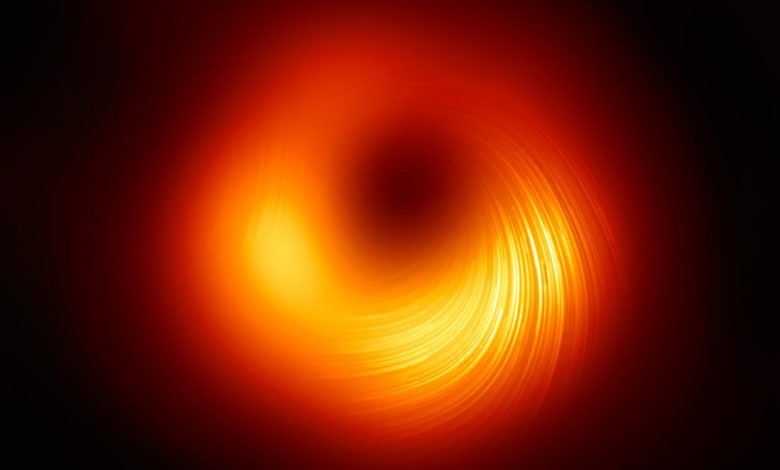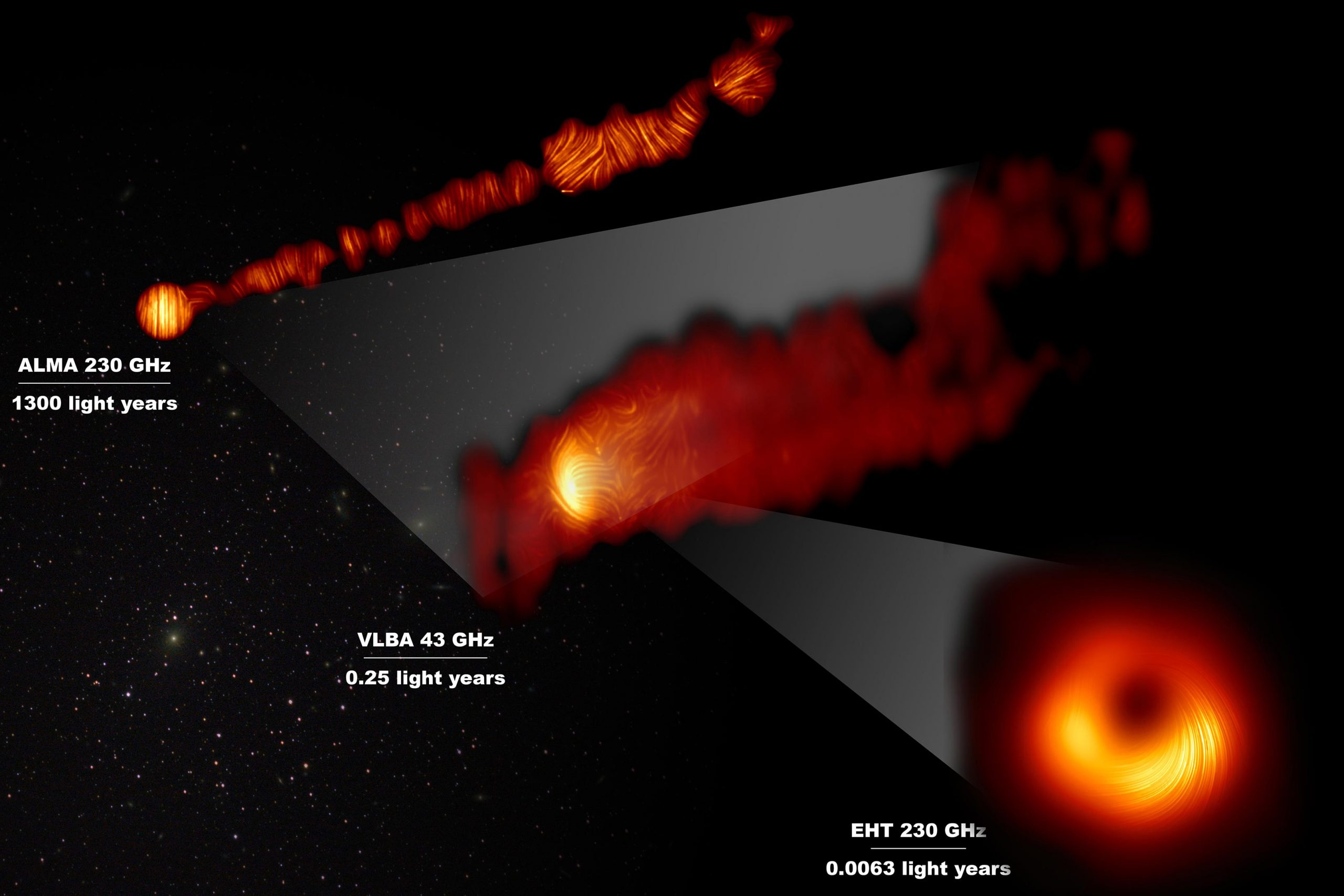
MIT Haystack Observatory is one of the 13 stakeholder institutions that constitute the Event Horizon Telescope (EHT) collaboration, which produced the first-ever image of a black hole. The EHT revealed today a new view of the massive object at the center of the M87 galaxy: how it looks in polarized light. This is the first time astronomers have been able to measure polarization, a signature of magnetic fields, this close to the edge of a black hole. The observations are key to explaining how the M87 galaxy, located 55 million light-years away, is able to launch energetic jets from its core.
In 2019, the Event Horizon Telescope (EHT) collaboration produced the first-ever image of a black hole, which lies at the center of the M87 galaxy 55 million light-years from Earth. The image showed a bright ring with a dark center, which is the black hole’s shadow. In capturing this image, astronomers noticed a significant amount of polarized light around the black hole. Now, the collaboration has revealed a new look at the black hole, showing what it looks like in polarized light.
On April 10, 2019, scientists released the first-ever image of a black hole, revealing a bright ring-like structure with a dark central region — the black hole’s shadow. Since then, the EHT collaboration has delved deeper into the data on the supermassive object at the heart of the M87 galaxy collected in 2017. They have revealed that the famous ring of light at the edge of the M87 black hole was polarized across the ring.
“Astronomers have obtained a new tool to study the magnetism of a black hole with the direct imaging of the polarization of light,” explains Kazunori Akiyama, a coordinator of the EHT Imaging Working Group and research scientist at Haystack Observatory. “This remarkable feat by the Event Horizon Telescope was truly achieved by years of international efforts to develop the state-of-the-art techniques in every single stage of the complex signal processing, from the telescopes to the images.”

“Polarization is a powerful tool available to astronomers to probe the physical conditions in one of the most extreme environments in the universe. It can provide clues not only to the strength and orientation of magnetic fields, but also how well-ordered those fields are, and possibly even something about the otherwise invisible material that lies between us and the material that is emitting the radio waves” says Colin Lonsdale, director of MIT Haystack Observatory and chair of the Event Horizon Telescope Board.
Polarized light waves have a different orientation and brightness compared with unpolarized light. And, just like how light is polarized when it passes through some sunglasses, light is polarized when it’s emitted in magnetized and hot areas of space.
The bright jets of energy and matter that emerge from M87’s core and extend at least 5,000 light-years from its center are one of the galaxy’s most mysterious and energetic features. Most matter lying close to the edge of a black hole falls in. However, some of the surrounding particles escape moments before capture and are blown far out into space in the form of jets.
Astronomers have relied on different models of how matter behaves near the black hole to better understand this process. But they still don’t know exactly how jets larger than the galaxy are launched from its central region, which is as small in size as the solar system, or exactly how matter falls into the black hole. With the new EHT image of the black hole and its shadow in polarized light, astronomers managed for the first time to look into the region just outside the black hole, where this interplay between matter flowing in and being ejected out is happening.
The observations provide new information about the structure of the magnetic fields just outside the black hole. The team found that only theoretical models featuring strongly magnetized gas can explain what they are seeing at the event horizon.
“New polarization images suggest that the powerful jet is formed by plasma flow arrested by aligned magnetic fields in the vicinity of the black hole, resisting its strong gravitational pull,” explains Kotaro Moriyama, an overseas postdoc fellow of the Japan Society for the Promotion of Science at Haystack Observatory.
To observe the heart of the M87 galaxy, the collaboration linked eight telescopes around the world, including ALMA (the Atacama Large Millimeter/submillimeter Array) and APEX (the Atacama Pathfinder Experiment) in northern Chile, to create a virtual Earth-sized telescope, the EHT. The impressive resolution obtained with the EHT is equivalent to that needed to measure the length of a credit card on the surface of the moon.
“ALMA plays a central role in the entire process: it is centrally located to tie the EHT array together, and it is also the most sensitive telescope in the array, so it is crucial to making the most of the EHT data,” says Geoff Crew, Haystack research scientist. “In addition, the years of work on the ALMA polarimetry analysis has delivered far more than we imagined.”
The Event Horizon Telescope (EHT) collaboration, who produced the first-ever image of a black hole, has today revealed a new view of the massive object at the center of the Messier 87 galaxy: how it looks in polarized light. This is the first time astronomers have been able to measure polarization, a signature of magnetic fields, this close to the edge of a black hole. This video summarises the discovery.
As polarization is a signature of magnetic fields, this image makes it clear that the black hole’s ring is magnetized. This polarized view “tells us that the emission in the ring is most certainly produced by magnetic fields that are located very close to the event horizon,” Monika Moscibrodzka, coordinator of the EHT Polarimetry Working Group and assistant professor at Radboud Universiteit in the Netherlands, told Space.com.
This is the first time that astronomers have been able to measure polarization so close to the edge of a black hole. Not only is this new view of this black hole spectacular to look at, but the image is revealing new information about the powerful radio jets shooting from M87.
“In the first images, we showed intensity only,” Moscibrodzka said about the first-released image of the object. “Now, we add polarization information on the top of that original image.”
“The new polarized images mark important steps towards learning more about the gas near the black hole, and in turn how black holes grow and launch jets,” Jason Dexter, Assistant Professor at the University of Colorado Boulder and coordinator of the EHT Theory Working Group, told Space.com in an email.
To capture the black hole, the collaboration used eight telescopes from around the world, combining their power to create a virtual Earth-sized telescope (the EHT).
“The radio telescopes of the EHT have receivers that record the sky signal in polarized light,” Ivan Marti-Vidal, also a coordinator of the EHT Polarimetry Working Group and GenT Distinguished Researcher at the Universitat de Valencia in Spain, told Space.com. “These polarized receivers work in a way similar to that of the polarized sunglasses that some people use.”
By showing the black hole in M87 through polarized light, the team got a better look at the object’s event horizon, which is also known as the “point of no return” because it’s the point at which no matter can get closer to the black hole without being pulled in. They also were able to better study the interaction with the object’s accretion disk, which is a disk of hot gas and other diffuse material that falls in toward a black hole and swirls around it.
The team’s observations and this new view of the object in M87 is deepening scientists’ understanding of the structure of magnetic fields just outside of a black hole, as it has remained a mystery how jets larger than the galaxy itself are emitted from the black hole at its heart.
“Astronomers have long thought that magnetic fields carried by the hot gas near black holes play an important role in letting the gas fall in, and in launching relativistic jets of energetic particles out into the surrounding galaxy. The polarized image we see tells us about the structure and strength of these magnetic fields very close to the black hole in M87, where the jet is launched,” Dexter said.
The resolution allowed the team to directly observe the black hole shadow and the ring of light around it, with the new polarized-light image clearly showing that the ring is magnetized. The results are published today in two separate papers in The Astrophysical Journal Letters by the EHT collaboration. The research involved over 300 researchers from multiple organizations and universities worldwide.
A third paper, “Polarimetric properties of Event Horizon Telescope targets from ALMA,” was also published in the Astrophysical Journal Letters, led by Ciriaco Goddi, a scientist at Radboud University and Leiden Observatory, the Netherlands, and including Haystack research scientists Geoff Crew and Lynn Matthews, and based on data from ALMA.
Goddi says, “The ALMA data were acquired simultaneously with the VLBI observations conducted in April 2017 with the EHT (and the GMVA); in this sense, they are a ‘byproduct’ of the VLBI operations. ALMA data were crucial to calibrate, image, and interpret the EHT polarization observations, providing tight constraints on the theoretical models that explain how matter behaves near the black hole event horizon. This data also provides a description of the magnetic field structure along the powerful relativistic jets that extend far beyond the M87 galaxy. The combined information from the EHT and ALMA allows scientists to investigate the role of magnetic fields from the vicinity of the event horizon to far beyond the M87 galaxy along its powerful relativistic jets (on scales of thousands of light-years).”
Crew adds, “ALMA bridges the gap in resolution between the ultra-high resolution of the VLBI arrays and that obtained with other measurement techniques. In combination, this wealth of new polarimetry data should allow us to make progress on understanding this fascinating object.”





